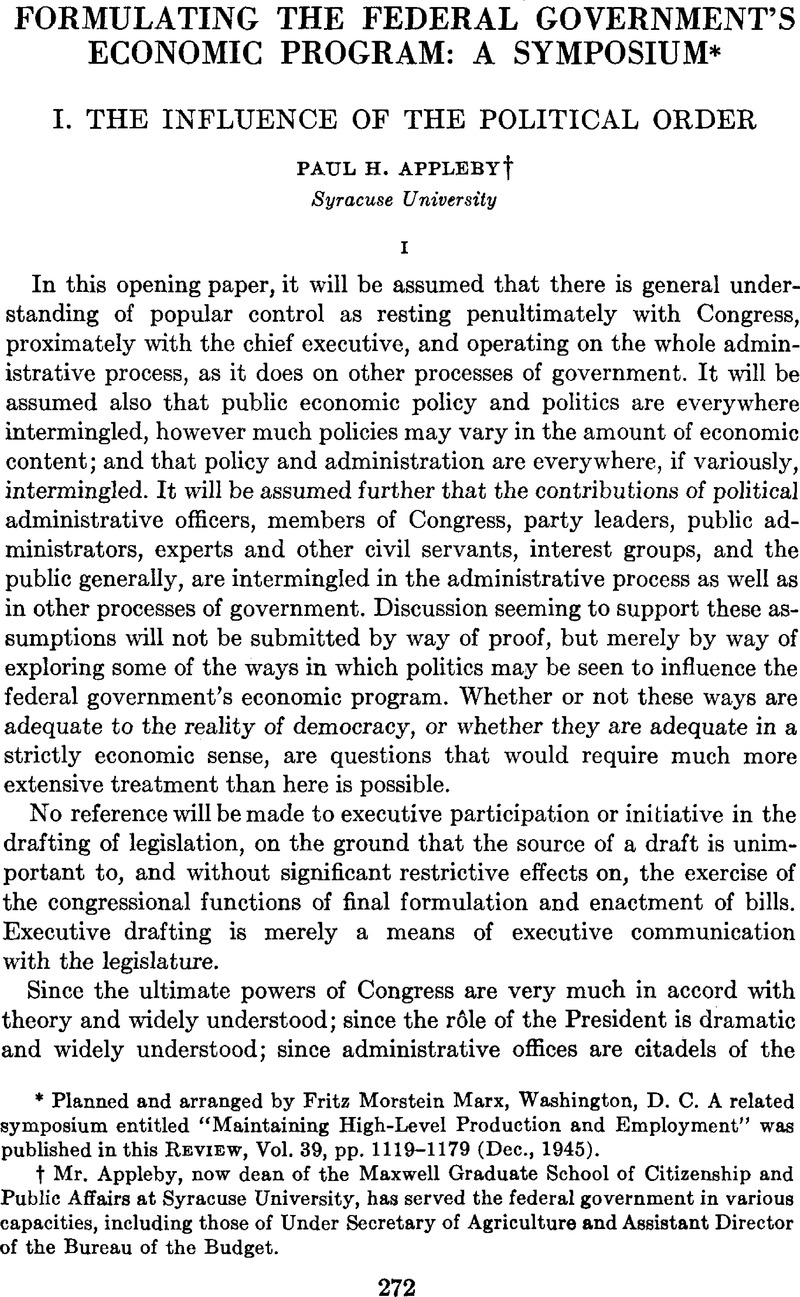Article contents
II. The Rôle of the Council of Economic Advisers
Published online by Cambridge University Press: 02 September 2013
Abstract

- Type
- Formulating the Federal Government's Economic Program: A Symposium
- Information
- Copyright
- Copyright © American Political Science Association 1948
References
1 The Full Employment Bill of 1945 was introduced by Senators James E. Murray (Montana), Robert F. Wagner (New York), Elmer D. Thomas (Utah), and Joseph E. O'Mahoney (Wyoming), and Representative Wright Patman (Texas); it was subsequently co-sponsored by many other senators and representatives.
2 For a fuller discussion of the declaration of policy in the Employment Act of 1946, see Part I of the Council of Economic Advisers' First Annual Report to the President, Dec., 1946.Google Scholar
3 Lippmann, Walter, in Washington Post, Dec. 26, 1946.Google Scholar
4 SenatorFlanders, Ralph E., “Administering the Employment Act—The First Year,” Public Administration Review, Vol. 7 (1947), p. 221.CrossRefGoogle Scholar
5 Public interest in these reports, particularly on the part of teachers of economics and political science, has been so great that they have been reprinted by a private publisher (Reynal and Hitchcock) in a single bound volume entitled The Economic Reports of the President (New York, 1948).
6 The members are Edwin G. Nourse, chairman; Leon H. Keyserling, vice-chairman; and John D. Clark.
7 The members are: Senators Robert A. Taft (Ohio), Joseph H. Ball (Minnesota), Ralph E. Flanders (Vermont), Arthur V. Watkins (Utah), Joseph C. O'Mahoney (Wyoming), Francis J. Myers (Pennsylvania), John Sparkman (Alabama), and Representatives Jesse P. Wolcott (Michigan), George H. Bender (Ohio), Robert F. Rich (Pennsylvania), Christian A. Herter (Massachusetts), Edward J. Hart (New Jersey), Wright Patman (Texas), Walter B. Huber (Ohio).
8 Established on executive initiative in 1939 (supplanting the National Resources Committee, which had been set up in 1935) and abolished by an appropriation act in 1943.
9 For an interesting set of proposals concerning the future operations of both, see Flanders, loc. cit. supra in note 4.
10 See its First Annual Report to the President, Dec., 1946; and its Second Annual Report to the President, Dec., 1947.
11 See The Impact of Foreign Aid upon the Domestic Economy, a report to the President by the Council of Economic Advisers, Oct., 1947.
12 House Committee on Expenditures in the Executive Departments, Report No. 1334 on Employment-Production Act (Dec. 5, 1945), p. 9.
13 The chairman of the Council has presented his interpretation of the economic services which the Council ought to render in a paper entitled “Economics in the Public Service,” at a meeting of the American Economic Association, Jan. 23, 1947. See American Economic Review, Proceedings, Vol. 37 (1947).
14 For reasons not developed here, the other two members of the Council “feel that both the President and the members of the Joint Committee, although occupying ‘political’ office, are strongly predisposed to draw upon objective economic analysis in fulfilling their defined functions under the Employment Act. They feel that, because the Council was established to assist the President in the preparation of his Economic Reports, the intent of the act will best be served if the Council extends coöperative professional assistance to the Joint Committee as, in its turn under the act, it comes to consider the fundamental materials contained in the President's Economic Reports as transmitted to the Congress.” In Senator Flanders' article (loc. cit. supra in note 4), the position is taken that the Council, in addition to the tasks specifically assigned it by the Employment Act, should also “assist the Congress in any way necessary to secure the adoption of the President's economic programs.” Ibid., p. 224.
15 The House committee explained this report as follows: “The committee has allowed $300,000 for the Council of Economic Advisers, a reduction of $50,000 below the appropriation for 1948 and $100,000 below the estimates for 1949. This agency has been the subject of searching inquiry on the part of the committee, many of the members being dubious as to its value. It appears that practically all of the information which the Council has used has been developed by other agencies of the government and could have been made available in useful form directly to the President by the agency originating it. There is little indication that, to date, the efforts of the Council in endeavoring to coördinate and interpret data have produced important results. However, this is a relatively new organization and the committee has made provision for it for another year and expects to follow its activities closely.”
16 The report of the Senate Appropriations Committee stated: “The committee is of the opinion that the work of the Council is of real importance and value to the government in assisting in the presentation of a coördinated picture of the national economy.” The next move is that of the conference committee.
17 Corson, John J., “Organizing Government Staff Services for Full Employment,” in this Review, Vol. 39 (1945), p. 1169.Google Scholar
- 5
- Cited by





Comments
No Comments have been published for this article.